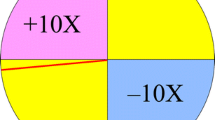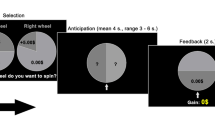Abstract
It has been widely found that in the Iowa Gambling Task (IGT; Bechara et al. Cognition, 50(1), 7–15 1994) normal subjects would gradually learn to prefer obtaining rewards for long-term benefits than seeking immediate rewards to maximize the overall profit. The current study aimed to gain an understanding of how punishment frequency in the IGT would be processed and its association with subjects’ reward preferences. In this study, we employed the clinical version of the IGT, in which response options are not only different in the long-term outcome, but also associated with different punishment frequencies. Event-related functional Magnetic Resonance Imaging (fMRI) was used to capture the subjects’ brain activity when performing the IGT. A total of 24 male subjects (mean age = 21.7 years, SD = 1.8 years), who were university students, participated in the experiment. It is found that subjects learned to select more from the decks that were advantageous in the long-term, but they were more sensitive to the effect of long-term outcome under the condition of high punishment frequency. The corresponding brain activation showed that the Anterior Cingulate Cortex (ACC) had significantly higher activation during the disadvantageous choices than the advantageous choices. Such activity difference between the two conditions of long-term outcome was more prominent with high punishment frequency than low punishment frequency; and this brain activity difference was significantly correlated with the behavioral performance under the condition of high punishment frequency. The results suggested that only in the context with high punishment frequency, there would be increased neural activity in ACC when subjects intended to select from the disadvantageous choices so that these choices would be inhibited and advantageous choices would be selected.






Similar content being viewed by others
References
Adinoff, B., Devous, M. D., Cooper, D. B., Best, S. E., Chandler, P., Harris, T., et al. (2003). Resting regional cerebral blood flow and gambling task performance in cocaine-dependent subjects and healthy comparison subjects. American Journal of Psychiatry, 160(10), 1892–1894.
Bechara, A., & Damasio, A. R. (2005). The somatic marker hypothesis: a neural theory of economic decision. Games and Economic Behavior, 52(2), 336–372.
Bechara, A., Damasio, A. R., Damasio, H., & Anderson, S. W. (1994). Insensitivity to future consequences following damage to human prefrontal cortex. Cognition, 50(1), 7–15.
Bechara, A., Damasio, H., Damasio, A. R., & Lee, G. P. (1999). Different contributions of the human amygdala and ventromedial prefrontal cortex to decision-making. The Journal of Neuroscience, 19(13), 5473–5481.
Bechara, A., Tranel, D., & Damasio, H. (2000). Characterization of the decision-making deficit of patients with ventromedial prefrontal cortex lesions. Brain, 123(11), 2189–2202.
Bechara, A., Tranel, D., Damasio, H., & Damasio, A. R. (1996). Failure to respond autonomically to anticipated future outcomes following damage to prefrontal cortex. Cerebral Cortex, 6(2), 215–225.
Bechara, A. (2004). The role of emotion in decision-making: evidence from neurological patients with orbitofrontal damage. Brain and Cognition, 55(1), 30–40.
Bechara, A., Damasio, H., & Damasio, A. R. (2003). Role of the amygdala in decision‐making. Annals of the New York Academy of Sciences, 985(1), 356–369.
Bechara, A., Damasio, H., Tranel, D., & Damasio, A. R. (1997). Deciding advantageously before knowing the advantageous strategy. Science, 275(5304), 1293–1295.
Bolla, K. I., Eldreth, D. A., Matochik, J. A., & Cadet, J. L. (2005). Neural substrates of faulty decision-making in abstinent marijuana users. NeuroImage, 26(2), 480–492.
Bolla, K., Eldreth, D., London, E., Kiehl, K., Mouratidis, M., & Contoreggi, C. (2003). Orbitofrontal cortex dysfunction in abstinent cocaine abusers performing a decision-making task. NeuroImage, 19(3), 1085–1094.
Bolla, K., Eldreth, D., Matochik, J., & Cadet, J. (2004). Sex-related differences in a gambling task and its neurological correlates. Cerebral Cortex, 14(11), 1226–1232.
Cahill, L., Uncapher, M., Kilpatrick, L., Alkire, M., & Turner, J. (2004). Sex-related hemispheric lateralization of amygdala function in emotionally influenced memory: an fMRI investigation. Learning and Memory, 11(3), 261–266.
Caroselli, J. S., Hiscock, M., Scheibel, R. S., & Ingram, F. (2006). The simulated gambling paradigm applied to young adults: an examination of university students’ performance. Applied Neuropsychology, 13(4), 203–212.
Cella, M., Dymond, S., Cooper, A., & Turnbull, O. (2007). Effects of decision-phase time constraints on emotion-based learning in the Iowa gambling task. Brain and Cognition, 64(2), 164–169.
Chiu, Y., & Lin, C. (2007). Is deck C an advantageous deck in the iowa gambling task. Behavioral and Brain Functions, 3(1), 37.
Clark, L., & Manes, F. (2004). Social and emotional decision-making following frontal lobe injury. Neurocase, 10(5), 398–403.
Crone, E. A., Bunge, S. A., Latenstein, H., van der Molen, & Maurits, W. (2005). Characterization of children’s decision making: sensitivity to punishment frequency, not task complexity. Child Neuropsychology, 11(3), 245–263.
Damasio, A. R. (1994). Descartes’ error: Emotion, rationality and the human brain. New York: Grosset/Putnam.
Ernst, M., Bolla, K., Mouratidis, M., Contoreggi, C., Matochik, J. A., Kurian, V., et al. (2002). Decision-making in a risk-taking task: a PET study. Neuropsychopharmacology, 26, 682–691.
Ernst, M., Kimes, A. S., London, E. D., Matochik, J. A., Eldreth, D., Tata, S., et al. (2003). Neural substrates of decision making in adults with attention deficit hyperactivity disorder. American Journal of Psychiatry, 160(6), 1061–1070.
Fellows, L. K., & Farah, M. J. (2005). Different underlying impairments in decision-making following ventromedial and dorsolateral frontal lobe damage in humans. Cerebral Cortex, 15(1), 58–63.
Fernie, G., & Tunney, R. J. (2006). Some decks are< i> better</i> than others: The effect of reinforcer type and task instructions on learning in the iowa gambling task. Brain and Cognition, 60(1), 94–102.
Frangou, S., Kington, J., Raymont, V., & Shergill, S. S. (2008). Examining ventral and dorsal prefrontal function in bipolar disorder: a functional magnetic resonance imaging study. European Psychiatry, 23(4), 300–308.
Fukui, H., Murai, T., Fukuyama, H., Hayashi, T., & Hanakawa, T. (2005). Functional activity related to risk anticipation during performance of the Iowa gambling task. NeuroImage, 24(1), 253–259.
Grabowski, T. J., Damasio, H., Eichhorn, G. R., & Tranel, D. (2003). Effects of gender on blood flow correlates of naming concrete entities. NeuroImage, 20(2), 940–954.
Hadland, K., Rushworth, M., Gaffan, D., & Passingham, R. (2003). The anterior cingulate and reward-guided selection of actions. Journal of Neurophysiology, 89(2), 1161–1164.
Horstmann, A., Villringer, A., & Neumann, J. (2012). Iowa Gambling Task: there is more to consider than long-term outcome. Using a linear equation model to disentangle the impact of outcome and frequency of gains and losses. Frontiers in Neuroscience, 6, 61.
Josephs, O., Turner, R., & Friston, K. (1997). Event-related fMRI. Human Brain Mapping, 5(4), 243–248.
Kennerley, S. W., Walton, M. E., Behrens, T. E., Buckley, M. J., & Rushworth, M. F. (2006). Optimal decision making and the anterior cingulate cortex. Nature Neuroscience, 9(7), 940–947.
Lawrence, N. S., Jollant, F., O’Daly, O., Zelaya, F., & Phillips, M. L. (2009). Distinct roles of prefrontal cortical subregions in the Iowa gambling task. Cerebral Cortex, 19(5), 1134–1143.
Li, X. (1983). The distribution of left and right handedness in Chinese people. Acta Psychologica Sinica, 15(3), 27–35.
Li, X., Lu, Z. L., D’Argembeau, A., Ng, M., & Bechara, A. (2010). The Iowa gambling task in fMRI images. Human Brain Mapping, 31(3), 410–423.
Lin, C., Chiu, Y., Lee, P., & Hsieh, J. (2007). Is deck B a disadvantageous deck in the iowa gambling task? Behavioral and Brain Functions, 3(1), 16.
Lin, C. H., Song, T. J., Chen, Y. Y., Lee, W. K., & Chiu, Y. C. (2013). Reexamining the validity and reliability of the clinical version of the Iowa gambling task: evidence from a normal subject group. Frontiers in Psychology, 4, 220.
Manes, F., Sahakian, B., Clark, L., Rogers, R., Antoun, N., Aitken, M., et al. (2002). Decision‐making processes following damage to the prefrontal cortex. Brain, 125(3), 624–639.
Martino, D. J., Bucay, D., Butman, J. T., & Allegri, R. F. (2007). Neuropsychological frontal impairments and negative symptoms in schizophrenia. Psychiatry Research, 152(2), 121–128.
Matsumoto, K., Suzuki, W., & Tanaka, K. (2003). Neuronal correlates of goal-based motor selection in the prefrontal cortex. Science, 301(5630), 229–232.
Ogawa, S., Lee, T., Kay, A., & Tank, D. (1990). Brain magnetic resonance imaging with contrast dependent on blood oxygenation. Proceedings of the National Academy of Sciences, 87(24), 9868–9872.
Paus, T. (2001). Primate anterior cingulate cortex: where motor control, drive and cognition interface. Nature Reviews Neuroscience, 2(6), 417–424.
Talairach, J., & Tournoux, P. (1988). Co-planar stereotaxic atlas of the human brain. 3-dimensional proportional system: An approach to cerebral imaging. New York: Thieme medical Publishers.
Tanabe, J., Thompson, L., Claus, E., Dalwani, M., Hutchison, K., & Banich, M. T. (2007). Prefrontal cortex activity is reduced in gambling and nongambling substance users during decision‐making. Human Brain Mapping, 28(12), 1276–1286.
Tranel, D., Bechara, A., & Denburg, N. L. (2002). Asymmetric functional roles of right and left ventromedial prefrontal cortices in social conduct, decision-making, and emotional processing. Cortex, 38(4), 589–612.
Tranel, D., Damasio, H., Denburg, N. L., & Bechara, A. (2005). Does gender play a role in functional asymmetry of ventromedial prefrontal cortex? Brain, 128(12), 2872–2881.
Tucker, K. A., Potenza, M. N., Beauvais, J. E., Browndyke, J. N., Gottschalk, P. C., & Kosten, T. R. (2004). Perfusion abnormalities and decision making in cocaine dependence. Biological Psychiatry, 56(7), 527–530.
Acknowledgments
The author Yufeng Zang is partly supported by “Qian Jiang Distinguished Professor” program.
Conflict of Interest
Shuangye Ma, Yufeng Zang, Vinci Cheung, and Chetwyn Chan declare that they have no conflict of interest.
Informed Consent
All procedures followed were in accordance with the ethical standards of the responsible committee on human experimentation (institutional and national) and with the Helsinki Declaration of 1975, and the applicable revisions at the time of the investigation. Informed consent was obtained from all patients for being included in the study.
Author information
Authors and Affiliations
Corresponding author
Rights and permissions
About this article
Cite this article
Ma, S., Zang, Y., Cheung, V. et al. Importance of punishment frequency in the Iowa gambling task: an fMRI study. Brain Imaging and Behavior 9, 899–909 (2015). https://doi.org/10.1007/s11682-015-9353-0
Published:
Issue Date:
DOI: https://doi.org/10.1007/s11682-015-9353-0




